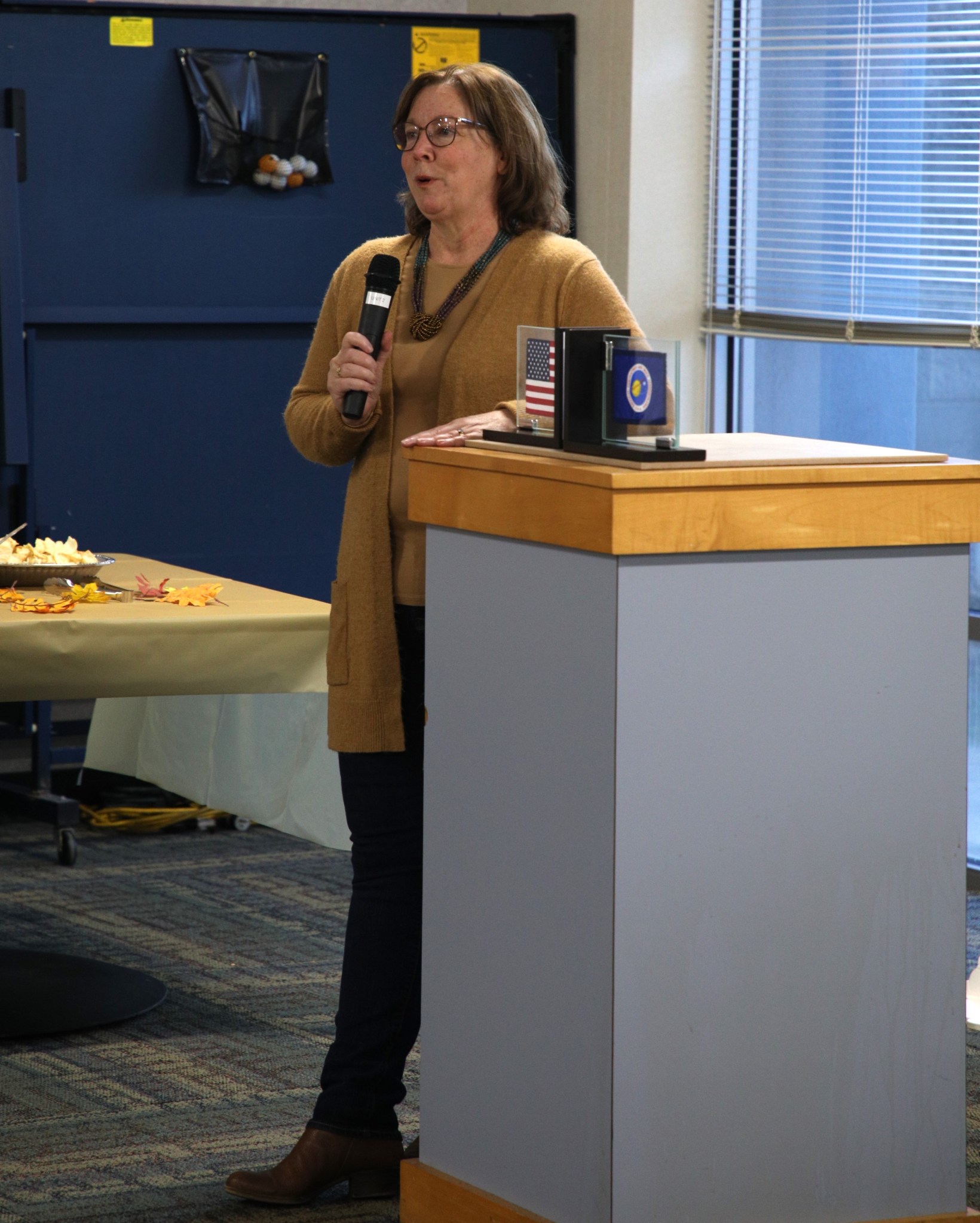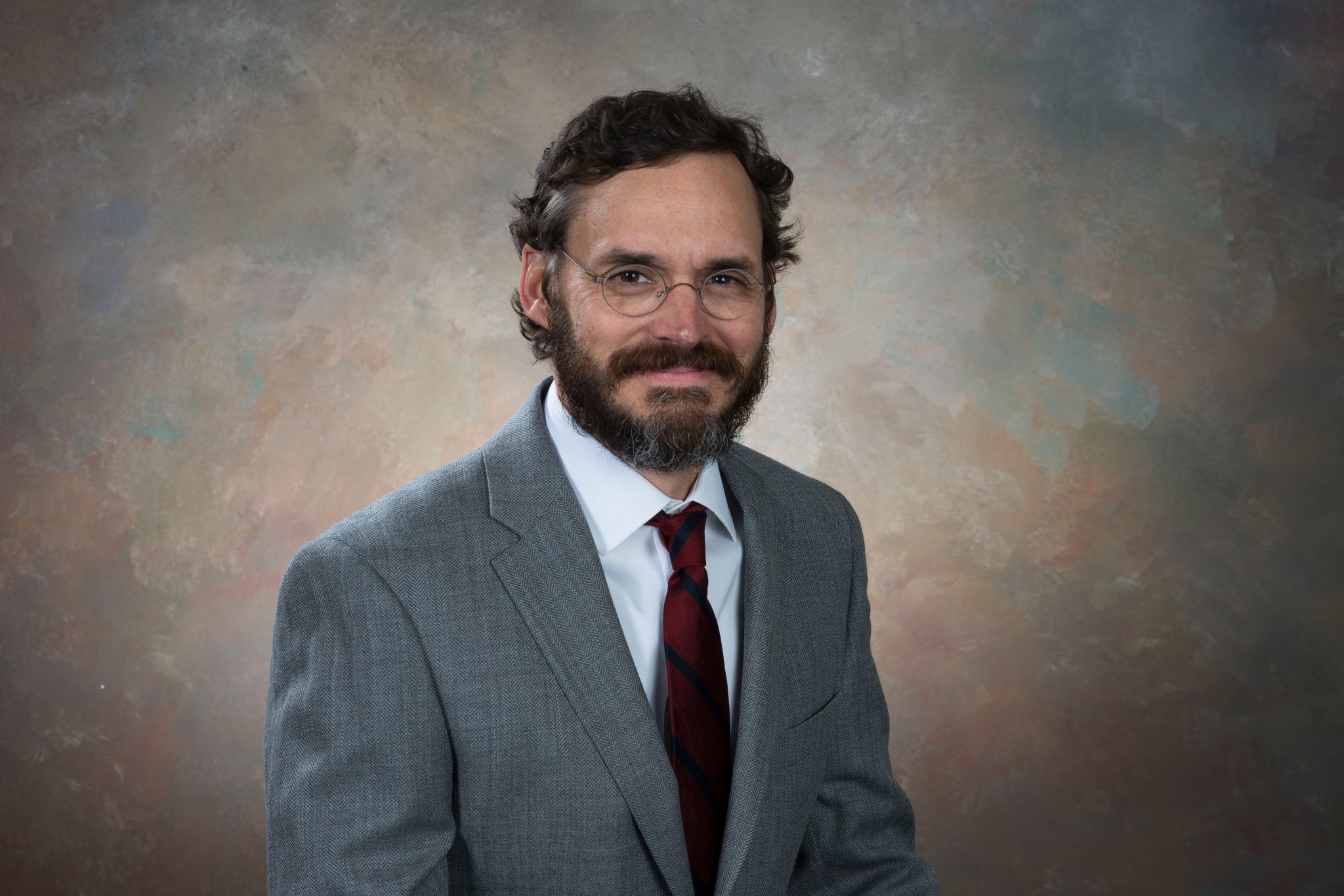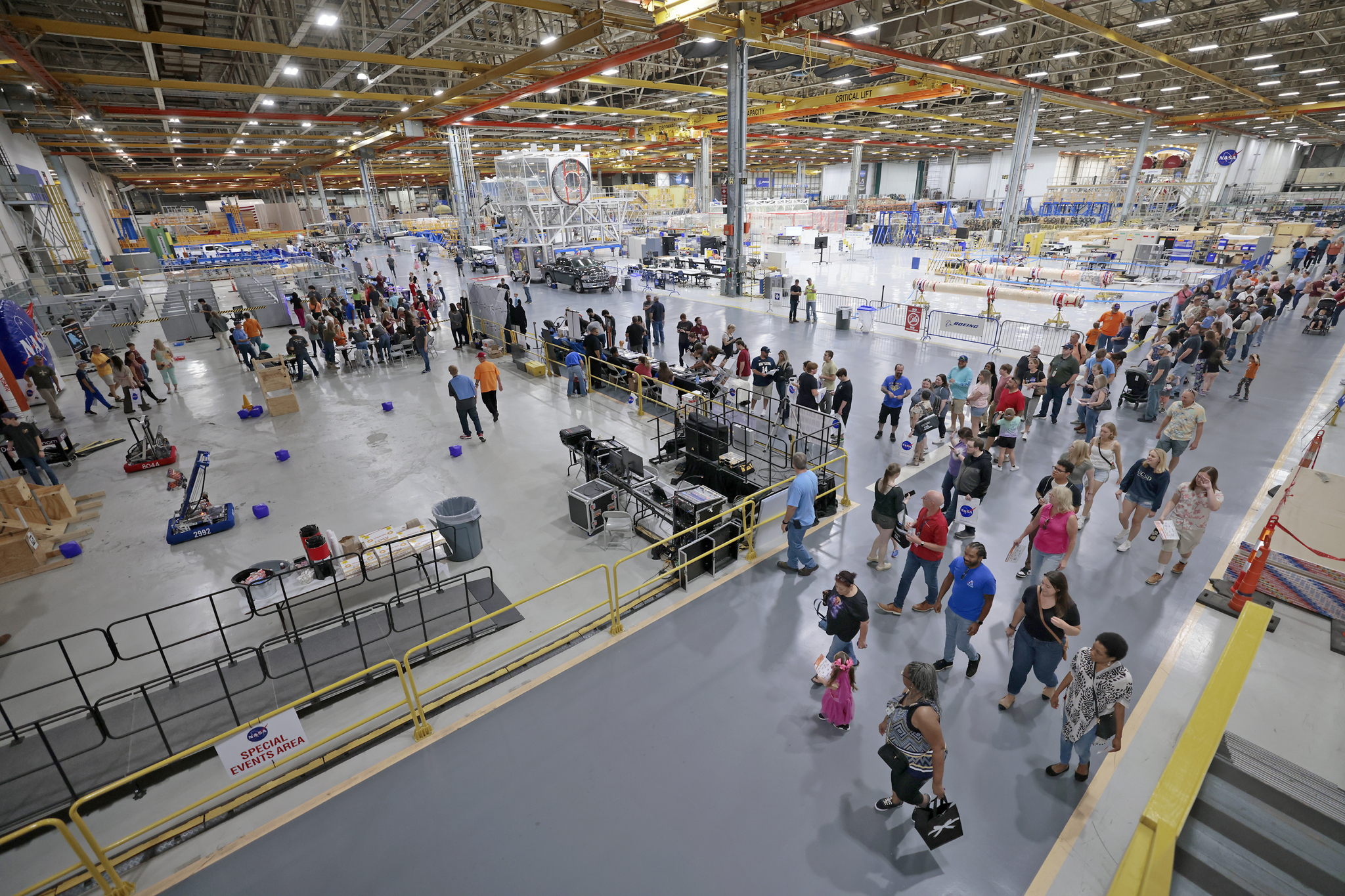Still Serving: Honoring Marshall, Michoud Veterans
Many members of the workforce at NASA’s Marshall Space Flight Center and Michoud Assembly Facility served in the U.S. Armed Forces before beginning their NASA careers, and some are still serving in both capacities today.
Their defense careers have been in a range of services, including the Army, Air Force, Coast Guard, Marine Corps, National Guard, Navy, and Reserves. Today, they continue to serve the nation through their work at NASA. As we approach Veterans Day, we pause to acknowledge their military service and hear their stories.
Get to know some of our Marshall and Michoud veterans.
Marshall’s First Woman Director of Engineering Directorate Celebrates Retirement
By Celine Smith
Mary Beth Koelbl, the first woman to serve as director of the Engineering Directorate at NASA’s Marshall Space Flight Center, celebrated her retirement among Marshall team members and family Nov. 2. Koelbl retires after serving 37 years at Marshall.
Marshall Associate Director, Technical, Larry Leopard gave a speech in honor of Koelbl’s impactful career. Both Leopard and Holder stressed how Koelbl’s personable character and great collaborative efforts made her career and teams successful.
“Mary Beth has provided outstanding public service to not only engineering but to the center,” Leopard said. “She has been a standard for everybody to follow.”
Appointed to the position in July 2019, Koelbl helped oversee Marshall’s largest organization, comprised of more than 2,000 civil servants and contractors responsible for the design, testing, evaluation and operation of flight hardware and software associated with space transportation and spacecraft systems, science instruments and payloads now in development at Marshall. The directorate provides critical support to NASA’s SLS (Space Launch System) Program, which is managing the construction and testing of the world’s most powerful rocket.
Don Holder was named new director of engineering after previously serving in the role of deputy director under Koelbl.
“Mary Beth Koelbl’s positive attitude toward people and caring about their development has benefited the organization tremendously,” Holder said.
Prior to this appointment, Koelbl was director of the Propulsion Systems Department from 2015 to 2019. In that position, she also served as NASA’s senior executive overseeing the agency’s chemical propulsion capability, leading work across multiple field centers to effectively develop, mature, and apply chemical propulsion capabilities in support of NASA’s missions.
Throughout her NASA career, Koelbl has supported large, complex propulsion systems development and operations efforts for SLS, NASA’s Commercial Crew Program, and various planetary lander development activities. She also contributed to historic efforts such as the space shuttle main engine technology test bed, the Fastrac 60K engine, all shuttle propulsion elements, the Altair spacecraft, and the Ares launch vehicle upper stage and upper stage engine.
Koelbl joined Marshall in 1986 as an aerospace engineer in the Turbomachinery and Combustion Devices Branch. She was named deputy group lead of the Engineering Directorate’s Engine Systems Engineering Group in 2000 and group leader in 2003. In 2005, following a center wide reorganization, Koelbl was named branch chief of the Engine and Main Propulsion Systems Branch. She was promoted to division chief of the Propulsion Systems Division in 2011, and later that year was named to the Senior Executive Service position of deputy director of the Propulsion Systems Department. The Senior Executive Service is the personnel system covering most of the top managerial positions in federal agencies.
“I have no plans of working after retirement because nothing could be better than this,” Koelbl said in her closing remarks at the reception.
A native of Iowa City, Iowa, Koelbl earned a bachelor’s degree in mechanical engineering in 1985 from the University of Iowa. She has been the recipient of many prestigious awards, including a NASA Exceptional Service Medal in 2018, NASA Leadership Medal in 2007, Space Flight Awareness Award in 2005, and Silver Snoopy in 1996.
Koelbl and her husband, Terry, who is also a NASA engineer at Marshall, reside in Madison with their three sons. She plans on enjoying her retirement by spending time with her children and grandchildren.
“I’m surely going to miss the people at Marshall – they’re the best,” Koelbl said.
Smith, a Media Fusion employee, supports the Marshall Office of Communications.
Don Holder Named Director of Marshall’s Engineering Directorate
Don Holder has been named director of the Engineering Directorate at NASA’s Marshall Space Flight Center.
In his new role, Holder will be responsible for the center’s largest organization, comprised of more than 2,000 civil service and contractor personnel, leading the design, testing, evaluation, and operation of flight hardware and software associated with space transportation, spacecraft systems, science instruments, and payloads under development at the center.
He previously served as the Engineering Directorate’s deputy director.
Holder joined Marshall in 1986 as a quality engineer supporting the Shuttle Propulsion Office. Since then, he has served in a multitude of technical leadership roles and has distinguished himself as a subject matter expert in ECLSS (Environmental Control and Life Support Systems). From 1989 to 1999, he served as a water recovery systems engineer supporting the development of water recovery technologies for the International Space Station.
Holder supported the ECLSS Project in positions of increasing scope and responsibility, including ECLSS Design team lead, technical assistant, and assistant chief engineer from 2000 to 2008.
In 2008, Holder was assigned as a project chief engineer for the space station, providing leadership for Marshall-provided flight hardware. From 2011 to 2013, he served as chief of the Mechanical Fabrication Branch in the Space Systems Department where he led a workforce of engineers and technicians and managed the numerous facilities required to support Marshall’s manufacturing needs.
Holder served as deputy chief engineer of the FPPO (Flight Programs and Partnerships Office) from 2013 to 2014 until being appointed to the Senior Level position of FPPO chief engineer in mid-2014 and subsequently Human Exploration Development and Operations chief engineer in 2017. He served as deputy director of the Space Systems Department from May 2019 to February 2021.
Lisa Bates Named Deputy Director of Marshall’s Engineering Directorate
Lisa Bates has been named deputy director of the Engineering Directorate at NASA’s Marshall Space Flight Center.
In her new role, Bates will be jointly responsible for the center’s largest organization, comprised of more than 2,000 civil service and contractor personnel, who design, test, evaluate, and operate flight hardware and software associated with Marshall-developed space transportation and spacecraft systems, science instruments, and payloads.
She was previously director of Marshall’s Test Laboratory. Appointed to the position in 2021, Bates provided executive leadership for all aspects of the Laboratory, including workforce, budget, infrastructure, and operations for testing.
She joined Marshall in 2008 as the Ares I Upper Stage Thrust Vector Control lead in the Propulsion Department. Since then, she has served in positions of increasing responsibility and authority. From 2009 to 2017, she served as the first chief of the new TVC Branch, which was responsible for defining operational requirements, performing analysis, and evaluating Launch Vehicle TVC systems and TVC components.
As the Space Launch System (SLS) Program Executive from 2017 to 2018, Bates supported the NASA Deputy Associate Administrator for Exploration Systems Development as the liaison and advocate of the SLS. Upon returning to MSFC in 2018, she was selected as deputy manager of the SLS Booster Element Office. Bates also served as deputy manager of the SLS Stages Office from 2018 to 2021 where she shared the responsibilities, accountability, and authorities for all activities associated with the requirements definition, design, development, manufacturing, assembly, green run test, and delivery of the SLS Program’s Stages Element.
Prior to her NASA career, Bates worked 18 years in private industry for numerous aerospace and defense contractors, including Jacobs Engineering, Marotta Scientific Controls, United Technologies (USBI), United Defense, and Sverdrup Technologies.
She holds a bachelor’s degree in mechanical engineering from the University of Alabama in Huntsville. She was awarded a NASA Outstanding Leadership Medal in 2013 and 2022 and has received numerous group and individual achievement awards. Bates and her husband, Don, reside in Madison and have four children.
Michoud Celebrates Family Day 2023 with Treats and No Tricks
By Matt Higgins
For the second consecutive year, NASA’s Michoud Assembly Facility hosted Family Day, a day when team members can invite their families to visit “America’s Rocket Factory.”
This year’s Family Day was Oct. 28.
“Family Day 2023 was a huge success,” said Michoud Director Lonnie Dutreix. “I enjoyed seeing the employees bring their families and seeing the looks of awe and smiling faces all around.”
Family Day occurred the weekend before Halloween. Team members and their families had the opportunity to view the latest stages of production in the 43-acre factory, including the fully assembled core stage for NASA’s SLS (Space Launch System) rocket for NASA’s Artemis II mission, and were treated to trunk-or-treat as they exited the factory. Michoud passed out candy and Moon Pies to trick-or-treaters of all ages.
“Family Day 2023 was an opportunity to build on last year’s success,” said Heather Keller, Michoud communications strategist and Family Day coordinator. “We even took advantage of the holiday weekend to include a trunk-or-treat for the kids.”
Mother Nature spared the heavy rains that occurred during Family Day 2022. The lack of rain and threatening skies allowed for more displays and attractions. There were food trucks outside the factory gates, and a Coast Guard Sikorsky MH-60 Jayhawk helicopter landed on the facility grounds. Attendees viewed the distinct orange and white helicopter up close, sat inside, and took pictures. NASA astronaut Stan Love and astronaut candidate Jack Hathaway took pictures with families in front of the SLS core stage for Artemis II in the Final Assembly area.
Michoud’s tenants, including its prime contractors Boeing and Lockheed Martin, set up booths and provided swag for those who passed by. Some tenants included interactive virtual reality displays and science experiments.
“With the addition of astronauts, a USCG rescue helicopter, food trucks, and emergency and heavy equipment static displays, there really was something for everyone,” Keller said.
Prior to 2022’s celebration, Michoud Family Day hadn’t occurred since before the COVID-19 pandemic, and strong thunderstorms kept many people away in 2022. It meant that this year’s event was the first time many family members had seen Michoud in years and the first for many others. Organizers estimated more than 5,000 attended the event.
For Dutreix, it marked one of the final major events of his tenure. He will retire in December.
“It’s my last Family Day as director,” he said. “I’m going to miss it, but I’m proud of the family atmosphere we have at Michoud. The workforce looks out for each other, and we’re committed to seeing Artemis succeed.”
Higgins, a Manufacturing Technical Solutions Inc. employee, works in communications at Michoud Assembly Facility.
Watch Crews Add RS-25 Engines to NASA Artemis II SLS Rocket
Artemis II reached a significant milestone as teams fully installed all four RS-25 engines to the 212-foot-tall core stage for NASA’s SLS (Space Launch System) rocket at NASA’s Michoud Assembly Facility.
During Artemis II, the four engines, arranged like legs on a chair at the bottom of the mega rocket, will fire for eight minutes at launch, producing more than 2 million pounds of thrust to send the Artemis II crew around the Moon.
Boeing is the lead contractor for the SLS core stage. Aerojet Rocketdyne, an L3Harris Technologies company, is the lead contractor for the SLS engines. NASA’s Marshall Space Flight Center manages the SLS Program and Michoud.
For more information about SLS, visit https://www.nasa.gov/sls.
NASA Telescopes Discover Record-breaking Black Hole
Astronomers have discovered the most distant black hole yet seen in X-rays, using NASA telescopes. The black hole is at an early stage of growth that had never been witnessed before, where its mass is similar to that of its host galaxy.
This result may explain how some of the first supermassive black holes in the universe formed.
By combining data from NASA’s Chandra X-ray Observatory and NASA’s James Webb Space Telescope, a team of researchers was able to find the telltale signature of a growing black hole just 470 million years after the big bang.

“We needed Webb to find this remarkably distant galaxy and Chandra to find its supermassive black hole,” said Akos Bogdan of the Center for Astrophysics | Harvard & Smithsonian (CfA) who leads a new paper in the journal Nature Astronomy describing these results. “We also took advantage of a cosmic magnifying glass that boosted the amount of light we detected.” This magnifying effect is known as gravitational lensing.
Bogdan and his team found the black hole in a galaxy named UHZ1 in the direction of the galaxy cluster Abell 2744, located 3.5 billion light-years from Earth. Webb data, however, has revealed the galaxy is much more distant than the cluster, at 13.2 billion light-years from Earth, when the universe was only 3% of its current age.
Then over two weeks of observations with Chandra showed the presence of intense, superheated, X-ray emitting gas in this galaxy – a trademark for a growing supermassive black hole. The light from the galaxy and the X-rays from gas around its supermassive black hole are magnified by about a factor of four by intervening matter in Abell 2744 (due to gravitational lensing), enhancing the infrared signal detected by Webb and allowing Chandra to detect the faint X-ray source.
This discovery is important for understanding how some supermassive black holes can reach colossal masses soon after the big bang. Do they form directly from the collapse of massive clouds of gas, creating black holes weighing between about 10,000 and 100,000 Suns? Or do they come from explosions of the first stars that create black holes weighing only between about 10 and 100 Suns?
“There are physical limits on how quickly black holes can grow once they’ve formed, but ones that are born more massive have a head start. It’s like planting a sapling, which takes less time to grow into a full-size tree than if you started with only a seed”, said Andy Goulding of Princeton University. Goulding is a co-author of the Nature Astronomy paper and lead author of a new paper in The Astrophysical Journal Letters that reports the galaxy’s distance and mass using a spectrum from Webb.
Bogdan’s team has found strong evidence that the newly discovered black hole was born massive. Its mass is estimated to fall between 10 and 100 million Suns, based on the brightness and energy of the X-rays. This mass range is similar to that of all the stars in the galaxy where it lives, which is in stark contrast to black holes in the centers of galaxies in the nearby universe that usually contain only about a tenth of a percent of the mass of their host galaxy’s stars.
The large mass of the black hole at a young age, plus the amount of X-rays it produces and the brightness of the galaxy detected by Webb, all agree with theoretical predictions in 2017 by co-author Priyamvada Natarajan of Yale University for an “Outsize Black Hole” that directly formed from the collapse of a huge cloud of gas.
“We think that this is the first detection of an ‘Outsize Black Hole’ and the best evidence yet obtained that some black holes form from massive clouds of gas,” said Natarajan. “For the first time we are seeing a brief stage where a supermassive black hole weighs about as much as the stars in its galaxy, before it falls behind.”
The researchers plan to use this and other results pouring in from Webb and those combining data from other telescopes to fill out a larger picture of the early universe.
NASA’s Hubble Space Telescope previously showed that light from distant galaxies is highly magnified by matter in the intervening galaxy cluster, providing part of the motivation for the Webb and Chandra observations described here.
The paper describing the results by Bogdan’s team appears in Nature Astronomy, and a preprint is available online.
The Webb data used in both papers is part of a survey called the Ultradeep Nirspec and nirCam ObserVations before the Epoch of Reionization (UNCOVER). The paper led by UNCOVER team member Andy Goulding appears in the Astrophysical Journal Letters. The co-authors include other UNCOVER team members, plus Bogdan and Natarajan. A detailed interpretation paper that compares observed properties of UHZ1 with theoretical models for Outsize Black Hole Galaxies is forthcoming.
NASA’s Marshall Space Flight Center manages the Chandra program. The Smithsonian Astrophysical Observatory’s Chandra X-ray Center controls science operations from Cambridge, Massachusetts, and flight operations from Burlington, Massachusetts.
The James Webb Space Telescope is the world’s premier space science observatory. Webb is solving mysteries in our solar system, looking beyond to distant worlds around other stars, and probing the mysterious structures and origins of our universe and our place in it. Webb is an international program led by NASA with its partners, ESA (European Space Agency) and the Canadian Space Agency.
Read more from NASA’s Chandra X-ray Observatory.
Lucy Discovery Highlighted on ‘This Week at NASA’
NASA’s Lucy spacecraft got a surprise when it flew by asteroid Dinkinesh on Nov. 1 – the first of multiple asteroids Lucy will visit on its 12-year voyage. The mission is featured in “This Week @ NASA,” a weekly video program broadcast on NASA-TV and posted online.
Images captured by Lucy revealed that Dinkinesh is not just a single asteroid, as was thought, but a binary pair. The primary aim of the Lucy mission is to survey the Jupiter Trojan asteroids, a never-before-explored population of small bodies that orbit the Sun in two “swarms” that lead and follow Jupiter in its orbit.
NASA’s Goddard Space Flight Center provides overall mission management, systems engineering, and safety and mission assurance. Lockheed Martin Space in Littleton, Colorado, built the spacecraft. Lucy is the 13th mission in NASA’s Discovery Program. NASA’s Marshall Space Flight Center manages the Discovery Program for the Science Mission Directorate at NASA Headquarters.
View this and previous episodes at “This Week @NASA” on NASA’s YouTube page.




































